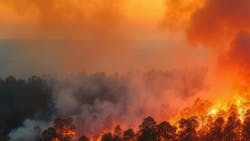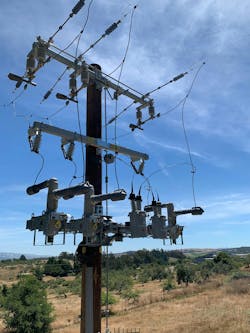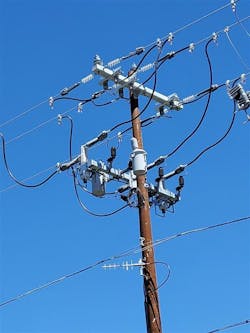How Flexible Recloser Design Strengthens Wildfire Mitigation
Wildfires pose an escalating threat to power systems, requiring solutions that can adapt to shifting environmental conditions and ongoing grid modernization efforts. Utilities must navigate the challenge of balancing reliability, safety, and cost-effectiveness in their wildfire mitigation strategies.
While system hardening and automation have taken center stage in recent years, the adaptability of protective devices, particularly reclosers, is emerging as a critical factor in wildfire risk reduction.
Flexible recloser design has a critical role in wildfire mitigation; adaptable technologies can help utilities safeguard power systems against the increasing threat of wildfires.
Adapting to High Fire Risk
Utilities operate across diverse landscapes, each presenting unique wildfire risks. Mountainous terrains, urban-wildland interfaces, and rural areas require tailored mitigation approaches. Furthermore, climate change is expanding wildfire-prone regions, compelling utilities to reassess and adapt their strategies continually. This necessitates a shift from rigid, one-size-fits-all solutions to flexible approaches that can be customized to specific needs and evolving conditions.
Modernization initiatives further underscore the need for adaptability. As utilities integrate system hardening, undergrounding, and advanced protection schemes, flexible solutions become essential for seamless integration and optimal performance.
Recloser Results
Reclosers play a crucial role in power system protection by automatically interrupting and restoring power flow in response to faults. The use of reclosers has evolved significantly since their inception in the 1940s. Initially, their primary function was simply to keep the lights on by restoring power after momentary faults. In the 2000s, their application became more refined, focusing on reliability improvements and minimizing industry indices like SAIDI (System Average Interruption Duration Index) and SAIFI (System Average Interruption Frequency Index). Today, with the growing threat of wildfires, recloser usage has been further fine-tuned to prioritize fire mitigation. This includes faster remote operation, rapid fault interruption, and even proactive power shutoffs during extreme weather events.
In the context of wildfire mitigation, the adaptability of reclosers is vital. Traditional reclosers with fixed parameters may not be sufficient to address the dynamic nature of wildfire threats. Modern wildfire mitigation demands precision and adaptability in recloser settings to respond effectively to evolving threats.
To effectively mitigate wildfire risks, utilities are leveraging flexible recloser settings that allow for real-time adjustments based on changing conditions:
- Sensitivity Adjustments: Fine-tuning sensitivity allows reclosers to detect high-impedance faults, often precursors to ignitions, which conventional overcurrent protection may miss.
- Fast Trip Settings: Rapid de-energization of lines during high-risk periods is crucial to prevent sustained arcing and ignition. Flexible reclosers enable utilities to implement fast trip settings without compromising coordination.
- Integration with Real-Time Monitoring: Integrating reclosers with weather monitoring and grid analytics allows dynamic adjustments to protection schemes based on real-time conditions. This proactive approach enhances responsiveness and reduces wildfire risk.
Utilities are increasingly recognizing the importance of flexible recloser design in their wildfire mitigation strategies. By adopting reclosers with adaptable settings and advanced functionalities, they can enhance grid resilience and minimize the risk of ignitions.
Flexible Recloser Design
G&W Electric’s Viper-ST recloser is designed for wildfire mitigation. Its adaptability makes it suitable for diverse grid environments and evolving wildfire conditions.
The recloser’s dead-front design enhances safety by preventing flashovers at the recloser itself, such as those caused by animal contact. This design minimizes the risk of ignitions originating from the recloser and minimizes exposure to live energy, reducing secondary ignition hazards and improving safety for personnel.
The recloser offers multiple current transformer (CT) ratio options, allowing for greater granularity at low current readings. This is essential for detecting high-impedance faults and downed conductors, which are often precursors to wildfires. Lower CT ratios provide enhanced sensitivity, enabling utilities to set lower trip thresholds in high-risk areas and prevent these incidents from escalating into fires.
Wildfire-Resilient Distribution Grids
The evolution of wildfire-resilient grids will be driven by continuous innovation and adaptation. Advanced automation, AI-driven analytics, and real-time monitoring will further refine recloser responses to dynamic fire conditions. Utilities should prioritize solutions that allow for modular upgrades, ensuring long-term adaptability and compatibility with emerging technologies.
Investing in flexible protection schemes, rather than rigid solutions, will be crucial for balancing wildfire mitigation with grid reliability and cost-effectiveness.
Solutions Beyond Reclosers
Key areas of focus for the future of wildfire-resilient distribution grids include advanced grid modeling and microgrids. Sandia National Laboratories is developing advanced grid modeling tools to simulate wildfire behavior and assess grid vulnerabilities. This research aims to improve utilities’ ability to assess, plan, and adapt to wildfire risks.
Microgrids, localized electrical networks that can operate independently, offer enhanced resilience during wildfires. They can provide backup power to critical facilities and communities, minimizing disruptions caused by grid outages. Microgrids do, however, require specialized protection schemes when connecting to the utility grid to ensure safe and reliable operation. Reclosers like the Viper-ST enable those protection schemes, allowing one device to be used for both distributed energy resource (DER) and microgrid integration, further enhancing their value in wildfire mitigation and grid modernization efforts.
Other potential solutions may include artificial intelligence, rerouting power flows and deploying sensors. Integrating fire-ignition electrical fault data with high-resolution Earth observation data can enhance wildfire risk assessment and prediction. AI-powered analytics platforms can analyze vast amounts of data to identify patterns, predict potential ignition points, and optimize mitigation strategies.
Research has shown that rerouting power flows through vulnerable parts of the grid during dry, windy conditions can decrease the probability of wildfire ignition. This methodology aims to improve decision-making in power systems operations to help utilities keep serving customers while reducing the risk of wildfire ignitions.
The development of wildfire sensors that detect gases and particulate levels is a promising area of innovation. These sensors can provide early warnings of fire ignitions, enabling rapid response and potentially preventing large-scale wildfires.
By embracing these advancements and adopting a forward-looking approach, utilities can build more resilient distribution grids that can withstand the growing threat of wildfires and ensure the continued delivery of safe and reliable electricity.
About the Author
Jeff Semelka
Jeff Semelka is a regional vice president for G&W Electric. He specializes in medium voltage equipment for utility and commercial and industrial (C&I) markets across the Western United States. With 25+ years of experience in sales and business development within the electric utility industry, Jeff helps customers enhance grid reliability and efficiency through advanced automation, integration, and protection solutions. Jeff holds a Bachelor of Science in Electrical Engineering from Valparaiso University and brings deep technical expertise in the application of products that modernize and safeguard electrical substations and distribution systems.


